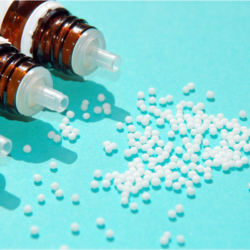The reality and place of homeopathy in modern medical practice
How is homeopathy defined?
Homeopathy is a medical discipline, i.e. it is prescribed by health professionals (doctors, dentists, midwives, veterinary surgeons) and recommended by pharmacists.
Homeopathic products are medicines(granules, drops, tablets, ointments, single doses) available exclusively in pharmacies, with or without a prescription, at the patient’s request.
How long has homeopathy been established and what are its principles?
Homeopathy was established over two centuries ago by a German doctor, Samuel Hahnemann. Disappointed by therapeutic methods and in particular by the undesirable effects of the treatments of his time, which led to numerous patient deaths, he set out to determine the dose of a substance that was sufficient to treat without being toxic. He experimented on himself with the effects of a number of substances and established the “law of similitude”: any substance capable of causing symptoms in a healthy subject could suppress those same symptoms in a sick subject.
This law, which founded the homeopathic doctrine, led to the development of
medicines containing active products.
Homeopathy is based on three inseparable principles: similitude,
infinitesimal dose and dynamisation.
At the time, Hahnemann empirically progressively reduced the doses by successive dilutions and by shaking his tube a large number of times to ensure sufficient mixing. This phase of shaking after dilution, known as dynamisation, was essential to the result.
How does homeopathy compare with conventional medicine?
First of all, there is no question of comparing or opposing them. A homeopathic doctor is first and foremost a doctor whose sole objective is to provide the best possible care, using the most effective and patient-friendly methods.Homeopathy is also referred to as an alternative and complementary medicine (CAM), in the same way as phytotherapy, acupuncture, naturopathy, hypnosis, etc. ….. What they all have in common is an approach that is as natural as possible. The particularity of homeopathy is that it takes into account all of the patient’s symptoms (physical,
the particularity of homeopathy is that it takes into account all of the patient’s symptoms (physical and psychological), so that comprehensive care and individualised treatment can be provided.
How does homeopathy fit into the modern medical approach?
However, the modern medical approach is based on the concept of integrative medicine, which refers to the joint use of conventional medicine and complementary alternative medicines to care for and monitor patients. Integrative medicine favours a more personalised approach to the treatment of the same pathology, and restores meaning to the relationship between carer and patient.
Homeopathy, by virtue of its intrinsic characteristics:
- Naturalness,
- Harmlessness:homeopathy is a therapy that respects physiopathology, with no undesirable effects and no risk of drug interactions.Homeopathy is suitable for treating fragile populations (babies, children, pregnant and breast-feeding women, the elderly and people taking multiple medications),
- A global approach to the patient:homeopathy enables treatment to be adapted to the patient’s clinical symptoms and psychological context (individualisation and personalisation of treatment)
Homeopathy therefore has its place in integrative medicine and meets many of patients’ expectations.
Current trends in homeopathy
In the current health context, homeopathy is positioning itself strategically, aligning itself with emerging trends that favour prevention and overall well-being. This development is closely linked to a growing interest in natural and holistic approaches, reflecting a search for balance and harmony in healthcare.
Firstly, homeopathy, with its non-invasive approach and nature-based treatment philosophy, responds perfectly to the growing demand for care methods focused on prevention. Instead of focusing solely on treating symptoms, homeopathy aims to strengthen the body as a whole, helping to prevent illness before it occurs. This preventive approach is part of a wider trend in modern medicine, which is gradually moving away from a reactive approach towards a proactive health strategy.
Alignment with natural and holistic approaches
Secondly, the current movement towards more personalised healthcare is echoed in homeopathic practice. With its emphasis on individualised treatment, homeopathy addresses the specific needs of each patient, taking into account not only their physical symptoms, but also their emotional and psychological state. This holistic approach, which considers the patient as a whole, is in line with the current trend towards medicine that is more focused on the person, rather than the disease.
What’s more, in a world where there is a growing awareness of the limitations and potential side-effects of conventional medicines, homeopathy offers an attractive alternative. Homeopathic remedies, known for their gentleness and low risk of side effects, are increasingly sought after by those concerned about the impact of chemical drugs on their bodies. This trend is particularly relevant in the treatment of vulnerable groups such as children, pregnant women and the elderly.
Finally, interest in integrative health practices, which combine conventional and alternative methods of care, has also contributed to greater acceptance and use of homeopathy. By integrating harmoniously into complementary care protocols, homeopathy enriches the range of treatment options available, offering a holistic response to contemporary health needs.
Homeopathy in practice?
Homeopathy can be prescribed for both acute illnesses, which occur suddenly and exceptionally, and chronic illnesses:
- In acute cases, repeat the doses very often, then space them out according to improvement (remember to consult a doctor if there is no noticeable improvement in your symptoms within 48 hours)
- In chronic cases, the doctor will favour long-term treatment to reduce the intensity and frequency of the patient’s attacks.
Granules of different medicines can be taken at the same time in the mouth. The medicine prescribed may vary depending on the patient, his or her profile, medical history and symptoms: two patients with the same illness may therefore be treated differently. However, the quantity of granules to be taken is the same regardless of weight or age, or whether the patient is a child or an adult. For paediatric use, dissolve the granules in a little water (glass, bottle) without heating.
Homeopathic treatments can be combined with conventional treatments. More and more often, they are combined in a complementary way (see Supra. the definition of integrative medicine).
What is special about the homeopathic approach?
This personalised approach is one of the foundations of homeopathy, recognising the uniqueness of each patient. In homeopathy, treatment is adapted not only to symptoms, but also to all individual characteristics, including emotional and psychological state, lifestyle habits and even personal reactions to different situations. This holistic approach makes it possible to develop a more targeted and tailored treatment, which is more effective.
Homeopathy also offers an alternative for those seeking less aggressive treatments or who cannot tolerate certain conventional medicines because of allergies or undesirable side-effects. This is particularly true in the treatment of children and the elderly, where the gentleness and tolerability of homeopathic remedies are particularly appreciated.
A holistic alternative
What’s more, the combined use of homeopathy and conventional medicine as part of integrative medicine offers a more holistic approach to health. This synergy can offer complementary solutions, for example, by using homeopathic treatments to manage the side effects of conventional medicines or to boost the patient’s immune system.
It is also important to stress the importance of the homeopathic doctor’s role in patient follow-up. Regular monitoring and adjustment of treatment is essential, especially in chronic cases where symptoms may evolve or change over time. The doctor must remain attentive to these variations in order to adjust the treatment accordingly, thus guaranteeing optimal care.
Finally, it is crucial to remember that the effectiveness of homeopathy, like any other form of treatment, depends on the accuracy of the diagnosis and the appropriateness of the remedy chosen. This requires in-depth expertise and understanding on the part of the practitioner, underlining the importance of ongoing training and updating knowledge in this constantly evolving field.
Did you know?
What’s the difference between 30CH and 9CH for granules (in tubes) or globules (in doses)?
It’s the number of dilutions made. For example, for a 9CH medicine, the starting solution (called the mother tincture) has been diluted and dynamised 9 times to the hundredth. The choice of dilution is
the choice of dilution is important: it depends on your particular situation, not your weight or age. Your doctor has carefully determined it in relation to the expected effect on your body.
Some key figures
- 61% of general practitioners use homeopathic medicines (1)
- 50% of cancer specialists are interested in the use of homeopathic medicines in supportive care (2)
- 40% of veterinary clinics include homeopathic medicines in their practice (3)
The place of homeopathy in different cultures and societies
Homeopathy, recognised for its ability to blend with a variety of medical practices and cultural traditions, has crossed geographical boundaries to become established in a wide range of societies. Originally a European practice, it has been adopted and adapted by many cultures, each integrating it in its own unique way into its healthcare system.
In India, for example, homeopathy has become a major component of the healthcare system. Recognised by the government and integrated as part of the AYUSH initiative (Ayurveda, Yoga and Naturopathy, Unani, Siddha and Homeopathy), it benefits from a vast infrastructure with dedicated hospitals and training institutes. This integration demonstrates the flexibility of homeopathy, which is able to coexist with traditional medical systems such as Ayurveda.
In South America, countries such as Brazil and Argentina have also adopted homeopathy, often used in tandem with conventional medicine. In Brazil, homeopathy is recognised by the Ministry of Health and is used in the public health system, indicating significant acceptance and confidence in the practice.
In Europe, despite uneven acceptance, homeopathy remains popular in countries such as France, Germany and the UK. In Germany, the birthplace of homeopathy, it is deeply rooted in medical culture and is often used as a complement to conventional treatments. In France, despite recent debates about its reimbursement by the social security system, homeopathy still enjoys considerable popularity, and is used by a large segment of the population.
Adaptation and integration of homeopathic practice worldwide
The adaptation of homeopathy in various cultural contexts is testimony to its flexibility and universality. In many cases, it has been adapted to meet local needs, incorporating existing cultural beliefs and medicinal practices. This ability to adapt not only leads to greater acceptance of homeopathy, but also contributes to a deeper understanding of health and well-being in a specific cultural context.
The success of homeopathy on a global scale also depends on its ability to adapt to the regulatory standards and expectations of health systems in different countries. In some cases, this means collaborating with conventional medical practitioners and conducting joint research to better understand its effectiveness and application.






